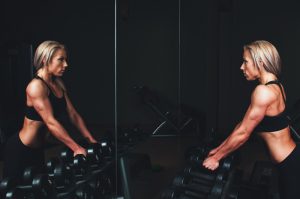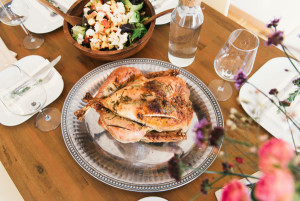“Yea, I stopped getting my period!!! That means I’m training really hard and am finally thin enough.”
“Yea, I’m glad I don’t have to deal with that monthly hassle any more.”
“Yea, now I don’t have to worry about getting pregnant!”
 Freedom from monthly menstrual periods has historically brought pride and pleasure to many female athletes. That is, until they experience infertility when they do want to get pregnant. To their misfortune, many of the same women who were very content having abnormally functioning bodies are now in a state of grief.
Freedom from monthly menstrual periods has historically brought pride and pleasure to many female athletes. That is, until they experience infertility when they do want to get pregnant. To their misfortune, many of the same women who were very content having abnormally functioning bodies are now in a state of grief.
For some, this is the first time their bodies are not doing what they want them to do: get pregnant! As Gigi Fernandez, Grand Slam tennis player stated, “As an athlete, you have this attitude, ‘I can do anything with my body.’ That’s how you think. So your biological clock is ticking, but you’re in denial.” She had seven failed fertility treatments.
Infertility in athletic women is a secret source of grief that hides in many couples’ closets. Infertility affects 1 in 6 women. An estimated 12% of those with infertility are athletes (1). If you are in the childbearing season of your life—or have a Millennial daughter, you likely know one or more athletic women who are struggling to conceive.
A Norwegian study with about 4,000 women identified two groups who had trouble conceiving:
- Women who trained every day, 11% of whom had fertility problems. This is three times more women than those who did not train at all.
- Women who trained until they were completely exhausted, 24% of whom had fertility problems. This is a 2.3 times more women than those who did low intensity exercise.
The women who did both—trained every day and trained to exhaustion—had the highest rates of infertility (2)
Many women fit into that category: marathoners, gym rats, triathletes and fitness enthusiasts, as well as elite athletes. Some of those active women may be simultaneously building their careers and choosing to delay starting a family. They may be unaware that fertility peaks at age 25, with diminishing returns year by year. By the time a woman is 40, her chances of getting pregnant without fertility treatments are far lower.
What girls and women need to know
Amenorrhea (loss of menses) is a cause of concern, not a reason to celebrate Unfortunately, parents or coaches are not teaching this fact to today’s high school girls. Or, the girls may not be really listening to the educational attempts. They are likely more interested in learning how to not get pregnant! The more relevant issue for this age group is that amenorrhea contributes to stress fractures. Yet, a 2014 survey indicates only 17% of 240 female high school athletes knew that amenorrhea makes bones weak. Only 25% knew that girls who skip their periods are prone to getting stress fractures. And 72% didn’t even know that amenorrhea is abnormal (3).
Despite popular belief, amenorrhea does not happen because a woman is training hard or has low body fat. After all, many female athletes are very lean, train very hard and do have regular periods. Athletes with amenorrhea fail to eat enough to support both exercise and menses. Add stress and perhaps other contributing factors, and Nature halts the possibility of a woman getting pregnant.
You might think these under-fueled female athletes would be very skinny and losing weight. Not always the case. When a woman is leaner than her genetic blueprint (as are many athletic women), her body has an amazing ability to conserve energy. Symptoms include cold hands and feet, slow heart rate, lethargy, and amenorrhea. No surprise an estimated 65% to 69% of competitive dancers and long distance runners have amenorrhea compared to 2% to 5% of the general population (4). And even if an athletic woman does have regular menses, she may not ovulate or have normal levels of reproductive hormones. This happens unknowingly in more than 75% of highly trained and recreational athletes.
CAUTION: Some female athletes have become pregnant on the belief amenorrhea is a convenient form of birth control. False. Women ovulate two weeks before they menstruate. If they just happen to be ovulating (fertile) prior to resuming menses, they can end up pregnant.
No Period. Now What?
 Athletic women who have stopped getting a monthly menstrual period or are having trouble conceiving may need help reversing the situation. The simple advice to “just eat a little more and exercise a little less” to correct the energy imbalance is much easier said than done. Amenorrhea is commonly wrapped up in disordered eating patterns. An estimated 20% to 60% of female athletes have a complicated relationship with food. They fear that eating more will lead to “getting fat,” hurting athletic performance, and losing their identity of being petite. Not the case. Eating adequate fuel gets the body out of hibernation (warmer hands, more energetic, happier, better mood), restores wasted muscles and allows well-fueled muscles to perform better
Athletic women who have stopped getting a monthly menstrual period or are having trouble conceiving may need help reversing the situation. The simple advice to “just eat a little more and exercise a little less” to correct the energy imbalance is much easier said than done. Amenorrhea is commonly wrapped up in disordered eating patterns. An estimated 20% to 60% of female athletes have a complicated relationship with food. They fear that eating more will lead to “getting fat,” hurting athletic performance, and losing their identity of being petite. Not the case. Eating adequate fuel gets the body out of hibernation (warmer hands, more energetic, happier, better mood), restores wasted muscles and allows well-fueled muscles to perform better
How much more does a woman have to eat? At least 13.5 calories per pound of lean body weight that she does not burn off with purposeful exercise. For a woman who weighs 120 pounds and has 18% body fat, that’s 102 lbs. x 13.5 cal/lb — about 1,400 calories. Now add in another 500 or so calories for a hard workout, and now you can understand why a 1,200-calorie diet can hinder fertility. A sports dietitian can help correct this imbalance, as well as help female athletes find peace with food.
If you have a hard time “eating normally,” please use the referral network at www.SCANdpg.org to find your local sports RD. You might also want to read No Period. Now What? (www.NoPeriodNowWhat.com) by N. Rinaldi & S. Buckler. This invaluable resource includes the personal fertility experiences of the authors as well as more than 400 athletic women who have had trouble conceiving. The book includes tips that help active women overcome their food fears, consume more fuel, boost fertility, become pregnant—and enjoy a healthier lifestyle afterwards. Yes!
Sports nutritionist Nancy Clark MS RD CSSD has a private practice in the Boston-area (Newton; 617-795-1875), where she helps both fitness exercisers and competitive athletes create winning food plans. Her best-selling Sports Nutrition Guidebook, and food guides for marathoners, cyclists and soccer are available at nancyclarkrd.com. For workshops, see www.NutritionSportsExerciseCEUs.com.
References
2. Gudmundsdottir S., Flandres W, Augestad L Physical Activity and fertility in women: the North-Trondelag Health Study, Human Reprod 2009; 24(12):3196-204
3. Brown K, Wengreen H, Beals K. Knowledge of the female athlete triad, and prevalence of triad risk factors among female high school athletes and their coaches J Pediatr Adolesc Gynecol 27: 278-282, 2014
4. Sundgot-Borgen J. Torstveit M. Prevalence of eating disorders in elite athletes is higher than in the general population. Clin J Sports Med 2004; 14(1):25-32
